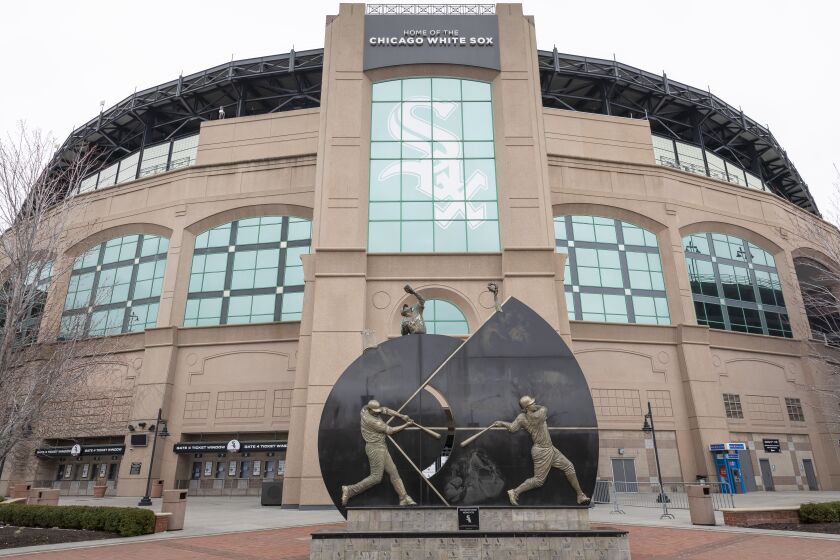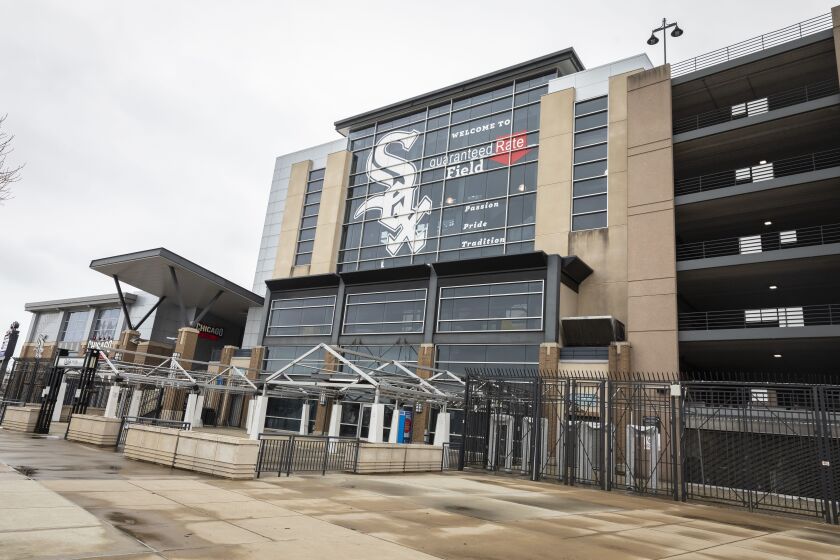Chicago developer Related Midwest envisions using a new White Sox stadium as a catalyst for a multibillion-dollar development on vacant South Loop land known as The 78 that will breathe new life into the downtown core.
Sources familiar with the plan fleshed out the developer’s vision for the 62-acre tract, which would include 5,000 residential units, 1,000 of them affordable, an office building, a hotel and dozens of restaurants and bars along a reinvigorated south riverfront.
The 35,000- to 38,000-seat stadium that would be the new home for the White Sox would be a piece of the puzzle but only a piece. The plan, if it comes to fruition, would allow the parcel to finally earn its nickname as Chicago’s “78th” neighborhood.
That vision wowed Ald. Nicole Lee, whose 11th Ward includes Bridgeport, where the Sox play now at Guaranteed Rate Field.
Lee was briefed Friday night by Related Midwest, as well as Sox chairman Jerry Reinsdorf and Terry Savarise, the team’s head of stadium operations. And she had to admit it looked too good for the Sox to pass up.
“What I saw was a very well-thought-out plan,” Lee told the Chicago Sun-Times Friday night. “You’re talking about a modern stadium built into sort of a master plan for a community. … That’s not something that falls out of the sky. We don’t have that” in Bridgeport.
“It breaks my heart to think that the team could go anywhere but stay on 35th Street. But it’s their business, and they have to make their own decisions.”
More than a ballpark
Also in the plans are 4,000 parking spaces beneath Roosevelt Road north of the stadium and, to the south, a school with thousands of students alongside a University of Illinois research center known as Discovery Partners Institute. The institute’s executive director, Bill Jackson, confirmed those were major elements of Related Midwest’s plans.
“The investment will be billions of dollars above just what the ballpark is for Phase 1,” said a source who has seen the plan. “It’s not just a ballpark. It’s a way to change a whole part of the city.
“Getting people back downtown ... is a hard economic necessity for this city,” the source added. “They’re going to come downtown because there’s stuff to do. … This is a massive step toward that. Somebody works in Willis Tower. They ... could walk to a ballgame and this incredible entertainment district built around it. It’s a bigger story than just a ballpark.”
Many questions remain, including how much Reinsdorf would be willing to contribute and how much public financing would be needed — given that demand for public resources is high, and public appetite for bankrolling stadiums is low.
Following the Chicago Sun-Times report earlier this week that the Sox were in serious negotiations about a move to The 78, Illinois Gov. J.B. Pritzker reiterated his skepticism about public funding for stadiums, telling reporters that “nobody’s made an ask yet” of the state or the Illinois General Assembly, and that he would be “looking at whatever they may be suggesting or asking.”
Pritzker added, “You know my views about privately owned teams and whether the public should be paying for private facilities that will be used for private business. Having said that, there are things that government does [to] support business all across the state.”
Could TIF money be used?
The City Council authorized a tax increment financing district in 2019 to bankroll infrastructure projects needed to prepare The 78, a former rail yard, for development.
But using TIF money for a stadium could be politically perilous for Mayor Brandon Johnson, who has promised to rein in TIFs and lucrative subsidies for developers.
The mayor’s $16.7 billion budget for 2024 used a record $434 million TIF surplus to deliver on his promise to hold the line on property taxes.
Even so, Johnson could be tantalized enough by the possibility of creating a new neighborhood in the South Loop that he’d consider bending on using TIF funds.
“The river is one of our greatest assets. If there was a southern anchor to the riverfront that was really driving traffic, activity and energy, that would have a significant impact on further maximizing that core asset. It would give us something to attract tourists and residents to the city,” a mayoral ally said.
The Illinois Sports Facilities Authority built and owns Guaranteed Rate Field. The authority has not yet been briefed on the new plan, but would likely be involved in financing a new baseball stadium using the usual sources of hotel, restaurant and other tourism taxes.
If the White Sox moved, the old ballpark would need a new user. Some have suggested the Chicago Fire soccer team could move there from Soldier Field. The Fire has not commented directly on that possibility, saying the club’s priority now is completing its training center on the Near West Side.
Lee said the White Sox and Related have thought about what’s next for the current stadium, and know “they can’t leave us with a hole.”
Lee also agreed “the Fire makes the most sense” as a new tenant.
Guaranteed Rate Field’s lease
Guaranteed Rate Field opened in 1991 adjacent to the team’s old home, the now-demolished Comiskey Park. Financing came together in an eleventh-hour deal that prevented the Sox from moving to St. Petersburg, Florida.
Then-Gov. Jim Thompson stopped the clock to lobby lawmakers, who approved the deal after the session’s midnight deadline in 1988. It included revenue generated by an increase in the tax on Chicago hotel rooms, and annual $5 million contributions from the city and state.
The initial lease was highly favorable to the Sox. For the first decade, the team paid no rent if annual attendance was below 1.2 million. Under its current lease, which runs through the 2029 season, the team pays $1.5 million in annual rent. The Sox control revenue from ticket sales, concessions, parking and merchandise operations.
And while the park has been renovated over the years, there has been no development around the park, though the lease was amended in recent years to allow the Sox to open a team store and a restaurant on state-owned land across the street.
Putting the White Sox in a denser part of the city would call for a different layout, with multilevel parking underground. Planners probably would figure many fans would get to games from the CTA’s Roosevelt Road station serving the Red, Green and Orange lines, and from ride-hailing services. Water taxis also are possible.
The new Sox stadium would be financed “like every other ballpark in America,” the source said. “There will be a number of different sources.”
Is downtown housing market saturated?
How many residential units the market could absorb remains unclear. Average rents downtown are still rising, although experts say the market has been chilled by the work-from-home trend and fears about downtown crime.
Ron DeVries, senior managing director at the Integra Realty Resources research firm, said Related’s South Loop site would be well-suited for multifamily housing because it’s so close to downtown and has frontage along the river. He also said the residences would be built in stages and won’t hit the market all at once.
“This is something that’s not going to get developed in the next five years,” DeVries said. “This has a long horizon.”
DeVries said the downtown market got about 3,000 new housing units in 2023, with another 3,500 projected this year. After 2024, the potential new supply drops dramatically, he said.
Almost all the construction is for rental apartments. Condo development has slowed to a crawl except in the limited market for multimillion-dollar units, analysts report.
Hotels, meanwhile, have seen a post-pandemic rebound in tourism and business meetings. A new hotel at The 78 could benefit from that and from major events at McCormick Place.
Related’s ambitious plans raise questions about whether they work well with the Discovery Partners Institute, planned on the property’s southern section near 15th and Wells streets. Jackson said he has seen a site plan and insists it all fits with his institute.
“We don’t have a problem with it. It brings the infrastructure that we would need regardless,” Jackson said.
The institute plans a $250 million complex aimed at bringing academics and researchers together with investors, with a goal of launching new businesses. It will not be a new campus for the U. of I., but an extension of the university that will promote “equitable economic development,” Jackson said.
Construction is due to begin later this year, with completion in 2026.
Another source described the U. of I. as “beyond excited” about the stadium-anchored plan.
“If you talk about why a kid wants to go to a school and why a professor wants to teach at a school and you put it in an environment like the one that would be created at The 78,” the source said, “it will make it one of the premier schools in the country immediately.”
Ald. Pat Dowell, whose 3rd Ward includes The 78, emerged from a meeting Friday with Related Midwest saying she believes the proposed Sox stadium “could be a positive anchor for the new 78 community.”
“Assuming the financial details can be worked out, this development shows promise as a growth opportunity for Chicago. ... The addition of significant market and affordable housing, retail and a world-class baseball stadium and concert venue can be the sort of catalytic investment this city needs,” Dowell said in a statement.
A former city planner, Dowell warned it is “extremely early” in the planning process and that “a number of concerns” must be addressed. They include the “traffic impact” on Roosevelt Road and 18th Street, security and “quality of life issues” that include concert noise and “pedestrian neighborhood access.”









